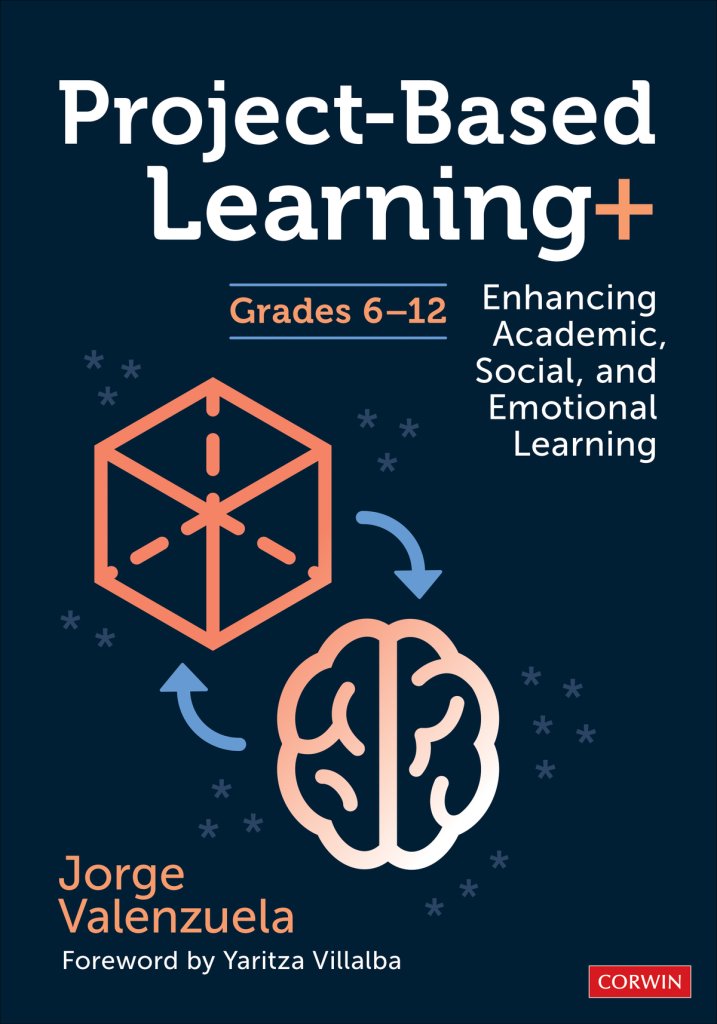Project-Based Learning for New Teachers
Building confidence to try PBL can be tough—here are some ways to integrate projects with the essential elements of core instruction.
Your content has been saved!
Go to My Saved Content.In my PBL coaching work, I'm big on teacher confidence and self-efficacy because many of us need more confidence in our teaching abilities. In my experience, confidence often holds some back from trying something new, like PBL, SEL, and new strategies. This in turn prevents them from growing their teaching practice.
Lacking confidence in our teaching can also be emotionally taxing—but it can be overcome with a few simple tweaks to how we plan and deliver our lessons. I also want you and the teachers I coach to get this benefit—which is why we are also focusing on confidence and sound core teaching practice in this chapter.

Lacking confidence as a teacher took a personal toll on me as I struggled immensely to assertively present information during monthly faculty meetings at the schools where I taught, in district meetings as a curriculum specialist, and later in workshops for adult learners. Don't get me wrong, I typically did a good job, but internally I would suffer from anxiety and self-doubt. This was not a good place to be and, in retrospect, wasn't worth the years of hardship. However, by paying close attention to sound core instruction and what I'm experiencing internally (emotionally), I have learned how to make all butterflies fly in the same direction. If I did it, so can you. It just takes practice, a solid foundational framework, and patience with oneself.
To deliver instruction with confidence, it's always important to pay close attention to sound practices for purposefully planning and teaching our lessons. If our core instruction is solid, we'll have a solid foundation for adding to our repertoire—including SEL-infused PBL. This means intentionally leveraging education research and our personal experiences with actionable steps through evidence-based instructional strategies and vetted educational protocols. This is often referred to as our pedagogical strategies (Edsys, 2018) and/or instructional design (Groshell, n.d.) practices for teaching and learning. All teachers should consider these types of items even when designing their PBL lessons, which we will cover in the forthcoming sections.
5 KEY BUILDING BLOCKS OF EFFECTIVE CORE INSTRUCTION
Core or Tier 1 instruction is the critical whole-group lessons teachers produce in primary subject areas that serve as a good backdrop for the differentiation strategies required to support struggling learners and those with diverse needs. Intentional and solid core instruction is critical for PBL, SEL, and other approaches to teaching. For example, a school beginning or enhancing the implementation of tiered instruction as part of a multi-tiered system of supports (MTSS) framework (S. Hurst, 2014) may need guidance in identifying and carrying out the components of Tier 1 instruction (Metcalf, n.d.). Tiers are designed to challenge students at their appropriate ability levels. Similarly, schools looking to use a Response to Intervention (RTI; Shapiro, n.d.) or PBL teaching model may need similar guidance on a good starting point for planning and facilitating lessons in tandem with helping teachers determine their students' learning needs.
But it's not enough for teachers to only have a sound system for planning and facilitating relevant lessons. They also need to monitor student engagement and academic achievement intentionally. This allows for tweaking and refining practice over time from an informed approach. To support the educators I coached, I created a versatile framework to serve as a good starting point for outlining the essential five must-have elements of good core instruction.
1. Relevant evidence-based curriculum. Curriculum refers to an evidence-based (Wing Institute, n.d.), standards, and competency-aligned sequence of planned experiences that help learners capture content concepts and applied skills that follow local standards, graduate profiles, career skills, SEL, and learners' interests. Teachers designing project unit plans must consider and nail down what kids need to learn and transfer in each project.
Although there's nothing wrong with carrying out core instruction using purchased curriculum and scripted resources, I don't recommend following said resources verbatim. There must be personalization of what you are teaching your unique learners, otherwise we risk losing student engagement due to lack of relevance.
Furthermore, to assist you and your planning teams in designing core instruction in meaningful and compelling ways for kids, try the empathy mapping process in tandem with straightforward backward design planning tools. The former can be powerful for determining relevance for students. The latter is a simple way to map and align learning goals with assessments, lessons, and sound instructional practices.
2. The promotion of literacy and numeracy skills across subject areas. Literacy and numeracy skills (Victoria State Government, 2022) are undoubtedly foundational for reading, writing, reasoning, and problem-solving across multiple disciplines. Even if you're not an English language arts or math teacher or utilizing a formal program for tiering and differentiation (e.g., MTSS, RTI, PBL), improving your core instruction should integrate literacy and math in ways that complement your core lessons meaningfully.
For example, science, social science, and elective teachers can highlight the reading and writing skills pertinent to the content they teach. As a science, technology, engineering, and math teacher, I've found that having my students outline the design process steps while paying attention to grammar, sentence structure, and citations significantly improves their literacy skills over time. In PBL, having kids create and rehearse using presentation scripts is also a powerful literacy builder that reinforces their speaking and listening skills (Valenzuela, 2019b).
Non-math teachers can help learners improve their basic knowledge of numbers by embedding numeracy skills into daily lessons in their PBL units. Skills may include building understanding in the following areas:
- Budgeting (Study.com, n.d.)
- Calculations (Cuemath, n.d.)
- Representing and interpreting data (Dacey & Eston, 2003)
- Measurement and data analysis (Tickled Pink in Primary, n.d.)
- Relationships between numbers (Peanut Butter Fish Lessons, n.d.)
3. High-yielding strategies to facilitate lessons. When used appropriately, high yielding strategies (Learning Focused, n.d.) have been shown to produce positive results in students' academic achievement. Having a set of go-to strategies for boosting critical thinking (Valenzuela, 2022g), cooperative learning, and providing feedback (Valenzuela, 2022c) (among other items) can strengthen core instruction and Tier 2 and 3 interventions. To remove your guesswork, in this book I have purposefully selected and uplifted strategies for implementing SEL and PBL that can produce high-yielding results.
Additionally, researcher Robert Marzano's work simplifies strategy selection because he outlines nine strategies (Technology & Learning, n.d.) to improve student achievement in any grade level or content area. Visible Learning research (Corwin, n.d.-b.) by John Hattie is also a good source for helping educators understand and adapt research to strategy selection in their particular context.
Try various strategies to gain insight into how they help learners succeed. Learn the appropriate times to use them because every strategy shouldn't be used daily or in every lesson and project.
4. Student engagement and academic achievement monitoring. Academic research supports (Dyer, 2015) a strong correlation between student engagement and student achievement, which teachers implementing PBL across grade levels and disciplines need to consider as a part of their core and daily instruction. In Visible Learning, John Hattie (2009, p. 32) writes, "No manner of school reform will be successful until we first face and resolve the engagement problem." Hattie's advice is essential not just for teachers but also for administrators and district supervisors to consider when implementing new instructional initiatives.
Monitoring student engagement is not difficult, but it must be intentional. Poll Everywhere (n.d.) recommends doing so in the following ways:
- Asking questions and leading discussions
- Observing participation in collaborative work by seeing how students respond in smaller settings
- Polling students using engagement surveys
Here are some good questions inspired by SurveyMonkey (n.d.) for you to consider when anonymously polling your students following PBL experiences:
- Rank this year's lessons and PBL units from easiest to hardest.
- Which activities did you learn from the most in our project?
- What are three things that can improve our next project?
- What is one thing you'd change about our project if you could?
- What advice would you give your teacher as I plan our next class project?
- What are you proud of accomplishing in our last class project?
- What do you want to learn in our next PBL experience?
Academic achievement should be monitored daily using informal and ungraded formative assessments throughout projects. Good assessment tools for strengthening core instruction may include thumbs-up responses and exit tickets. Quizzes, biweekly, end-of-unit, and benchmark assessments are metrics your district may have in place for you to use.
5. An understanding of your own impact. Hattie explains the importance of listening to our students to inform us of our impact on their engagement and learning (Professional Learning Supports, 2014); we can also seek feedback from trusted colleagues. When teachers consider themselves learners, it is easier to have conversations with students and colleagues about the areas of our core instruction within PBL units that we can improve.
Excellent practice requires vulnerability and focuses on what's not working with our core teaching and particular students. Seeking the right strategies for improving our impact becomes intentional instead of jumping on the latest teaching trend(s).
Surveying, polling, and student conferences can help improve teaching impact. You might ask questions such as the following (QuestionPro, n.d.):
- Which classroom activities help you learn most?
- What changes do you recommend I make to help you learn better? What motivates you to learn most?
- What can I do better?
- What aspects of projects do you enjoy?
- What would make project work more meaningful to you?
Excerpted from Project-Based Learning+, Grades 6-12: Enhancing Academic, Social, and Emotional Learning by Jorge Valenzuela, published by Corwin Press. Copyright 2024 by Corwin Press.
